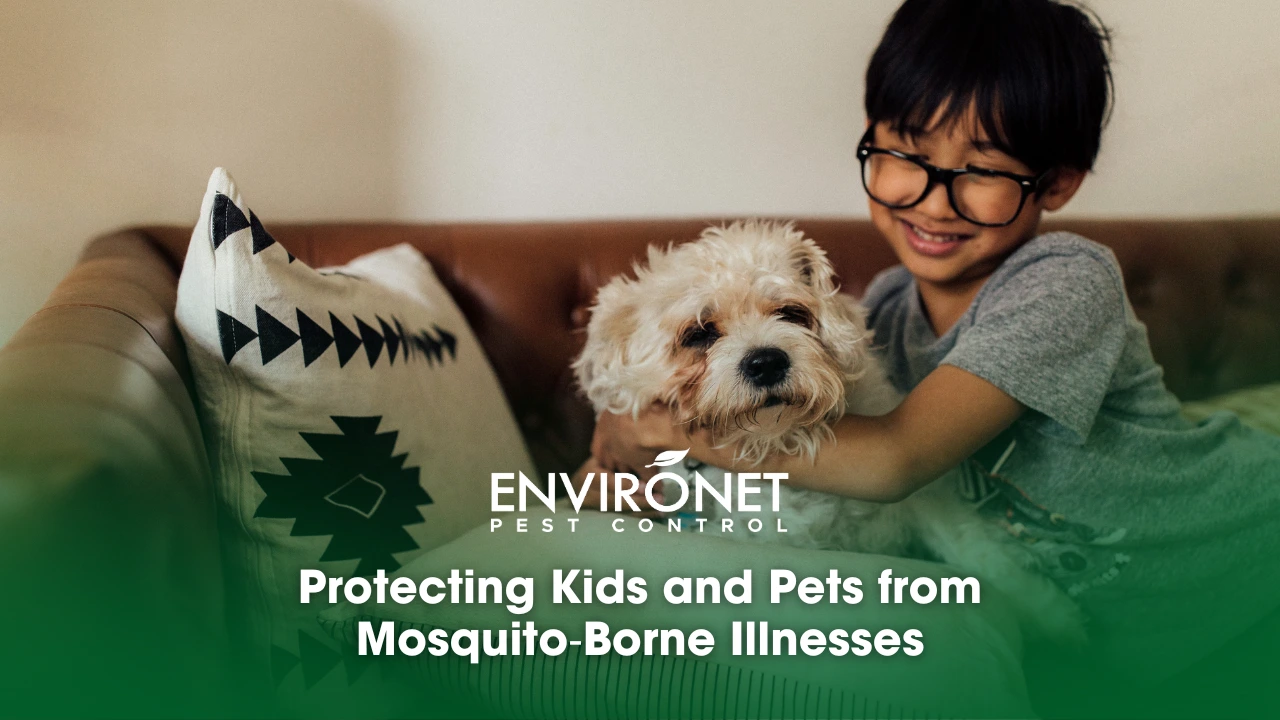
Protecting Kids and Pets from Mosquito‑Borne Illnesses
Last updated on November 4th, 2025 at 01:35 pm
Mosquitoes are more than just a nuisance — in tropical countries like the Philippines, they carry serious risks for both children and our furry family members. This blog covers what you need to know, and actionable steps you can take to protect kids, pets, and your home.
Why children and pets are at higher risk
For kids
-
In the Philippines, the mosquito‑borne viral infection Dengue Fever remains hyperendemic: it circulates all year. Manila Bulletin
-
Children are more vulnerable to severe dengue, because many have already been exposed to one serotype by early age, which increases risk for complications when they are infected again with another serotype. Manila Bulletin
-
Kids often play outdoors or near standing water—making them more exposed to mosquito bites and breeding sites.
-
According to a local parenting guide, protecting children includes wearing long‑sleeved clothes, installing screens, and using repellents. smartparenting.com.ph
For pets
-
Pets, especially dogs, are also bitten by mosquitoes and at risk for mosquito‑transmitted diseases. One key disease is Heartworm disease in dogs, transmitted when a mosquito carrying the parasite bites them. ph.virbac.com
-
Mosquito bites on dogs aren’t just itchy—they can carry real danger. For example, one case study documented a dog having an acute allergic reaction to bites from Aedes aegypti mosquitoes. PubMed
-
Pets with outdoor access or that spend a lot of time in poorly screened areas are at higher risk.
Common mosquito‑borne illnesses you should know about
Dengue
-
Carried by Aedes mosquitoes (primarily Aedes aegypti and Aedes albopictus) which bite during the day. Manila Bulletin
-
Symptoms include high fever, severe headache, pain behind the eyes, muscle and joint pain, rash. cmc.ph
-
Severe dengue may lead to bleeding, low blood pressure (shock) or organ failure. Manila Bulletin
Chikungunya & Zika
-
These are also transmitted by Aedes mosquitoes. In the Philippines, a study found that among patients in provincial hospitals, ~57% had dengue and ~7% had chikungunya. MDPI
-
Knowing these diseases helps broaden awareness beyond only dengue.
Lymphatic Filariasis
-
Also mosquito‑borne. The Lymphatic Filariasis is caused by parasitic worms transmitted by mosquitoes and is present in tropical regions, including parts of the Philippines. Manila Standard
Heartworm disease in pets
-
For dogs: when a mosquito bites an infected animal, it picks up microfilariae and can transmit them to a healthy dog. The worms mature in the heart & lungs of the dog, causing serious illness. ph.virbac.com
-
Preventive measures are much easier than treatment once infection is advanced.
How you can protect kids and pets: prevention strategies
1. Eliminate mosquito breeding sites
-
Mosquitoes need stagnant water to breed. Good housekeeping includes: emptying plant saucers, clearing gutters, removing old tires or containers that collect rainwater.
-
In the Philippines, health agencies advise the “search and destroy” of breeding sites especially in rainy season.
2. Physical protection for children
-
Clothing: have children wear long‑sleeves and pants, especially during peak mosquito activity hours.
-
Install window and door screens; use mosquito nets for younger children or sleeping areas.
-
Use effective mosquito repellents: in children, apply to exposed skin (not hands or near mouth/eyes) and follow manufacturer instructions.
3. Protection for pets
-
Keep pets indoors during times when mosquitoes are most active (dawn/dusk) and avoid letting them roam freely in mosquito‑prone environments.
-
Remove standing water in the pet’s surroundings (pet bowls, puddles, rain‑collecting containers).
-
Use pet‑safe mosquito preventives / heartworm preventives as recommended by a veterinarian. For dogs, this is critical.
4. Awareness and early action
-
For children: if fever lasts > 2 days, with rash/muscle‑joint pain, seek medical attention — especially in dengue‑prone areas.
-
For pets: monitor signs such as persistent coughing in dogs, decreased exercise tolerance, weight loss — could hint at heartworm or other conditions.
5. Community & home measures
-
Fogging or spraying may be used in outbreak hotspots, but it is not a standalone solution — source reduction and protective behaviour matter most.
-
Encourage neighbours to also clean and protect breeding areas — mosquito control is most effective when the whole community participates.
Summary
Protecting kids and pets from mosquito‑borne illnesses is about combining awareness, proactive prevention, and timely response. For children, safeguarding their environment and using protective measures is crucial. For pets, mosquito bites are not just annoying—they can lead to serious health issues like heartworm.
At Environet Pest Control, we help families and businesses take the guesswork out of mosquito prevention. Our professional Mosquito Control services target breeding sites, reduce mosquito populations around your home, and provide long-term protection, giving you peace of mind that your loved ones—both two-legged and four-legged—are safe.
Don’t wait for the rainy season to see mosquitoes thrive. Protect your family and pets today with Environet’s Mosquito Control services.
